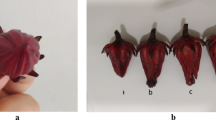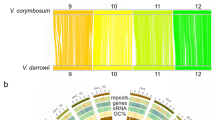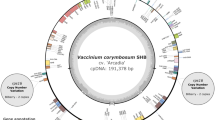Abstract
IT was previously noted1,2 that the lowbush blueberry, Vaccinium angustifolium Ait., will respond to gibberellic acid (GA) placed on the open flower, by the formation of parthenocarpic fruit. It has not been possible to effect the same response in the field on any broad scale. The reasons for this are not understood, but some evidence has been obtained to suggest that certain clones are more receptive to GA than others. The period of receptivity to the growth substance is also well defined and the parthenocarpic fruits seem to swell up more slowly than do seeded berries.
This is a preview of subscription content, access via your institution
Access options
Subscribe to this journal
Receive 51 print issues and online access
$199.00 per year
only $3.90 per issue
Buy this article
- Purchase on SpringerLink
- Instant access to full article PDF
Prices may be subject to local taxes which are calculated during checkout
Similar content being viewed by others
References
Barker, W. G., and Collins, W. B., Canad. J. Bot., 42, 1102 (1964).
Barker, W. B., and Collins, W. B., Proc. Amer. Soc. Hort. Sci., 87, 229 (1966).
Hall, I. V., and Ludwig, E. R., Canad. J. Bot., 39, 1733 (1961).
Barker, W. B., Wood, F. A., and Collins, W. B., Nature, 198, 810 (1963).
Author information
Authors and Affiliations
Rights and permissions
About this article
Cite this article
WOOD, G., COLLINS, W. & BARKER, W. Observations on the Parthenocarpic Response of Blueberry to Gibberellic Acid. Nature 211, 864 (1966). https://doi.org/10.1038/211864a0
Issue date:
DOI: https://doi.org/10.1038/211864a0



